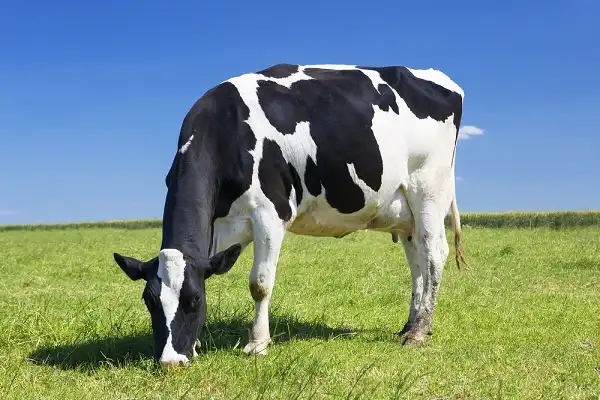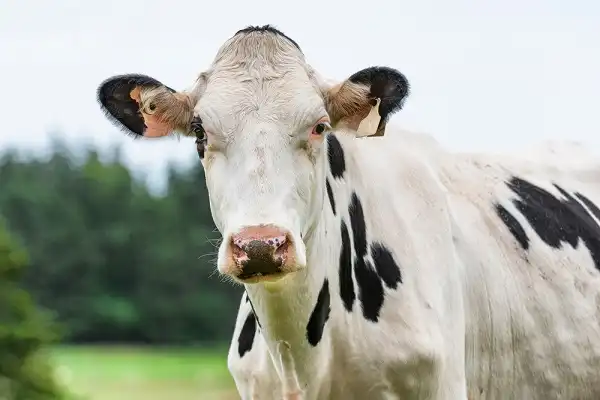Cows may seem like large, docile animals, but they are actually quite interesting creatures. For example, did you know that cows have excellent hearing and can remember up to 30 other cows? Read on to learn more interesting facts about these fascinating animals.

Cow Description
Cows are large, four-legged animals that are commonly found on farms and in pastures. These mammals belong to the bovine family and can weigh up to 1,800 pounds! Cows are herbivores, meaning they feed mostly on grasses and other types of vegetation. They have an impressive digestive system that enables them to break down a variety of tough and fibrous plants into proteins and energy. Cows have excellent hearing capabilities; they can recognize individual calls made by other cows from up to a mile away. Even more impressive, cows have the ability to remember the faces of up to 30 different cows! This unique ability is thought to be important in maintaining social relationships within cow herds. Cows have another interesting trait: they have four stomachs! The first three, known as the rumen, reticulum, and omasum, work together as one giant fermentation vat where bacteria break down ingested cellulose. The fourth stomach, known as the abomasum, is similar to a human stomach in which acid helps digest food. After digestion has taken place in the abomasum, what remains passes through an intestine before being excreted as manure.
Cow Habitat
Cow habitat varies greatly depending on the region. In temperate climates, cows are typically kept in pastures, where they graze and roam freely. These cows often have access to barns or sheds for protection from extreme weather conditions. In other climates, such as tropical areas, cows are more likely to be kept in an enclosed area with limited access to grassland and grazing. Some farms also employ a method of rotational grazing, which involves moving the herd from one area to another in order to encourage the regrowth of forage plants and improve the health of the soil.
When living on a farm or pasture, cows may be exposed to various types of predators including coyotes, wolves, bears, bobcats, and even mountain lions. To protect against these threats, farmers often set up fences or install guard dogs to ensure their safety. In urban areas, however, cows may be housed indoors where they can receive regular medical care and be better monitored for diseases that develop due to poor nutrition or inadequate housing conditions. Cows that are moved indoors may have access to different sorts of feed that is not available outdoors such as hay cubes or processed grains like corn and soybeans.

Cow Diet
Cows are herbivores, meaning they only consume plant-based food. In the wild, cows generally graze on grass and other types of vegetation found in their natural environment. On farms and pastures, they are typically given access to hay, alfalfa, corn silage, and other feed sources that contain all of the nutrients they need to stay healthy and productive. In addition to grasses and hay, cows will also consume a variety of other plants such as legumes, roots, leaves, and stems. Cows are able to digest cellulose from these plants using their four stomachs; the rumen, reticulum, omasum, and abomasum work together like one giant fermentation vat where bacteria break down ingested cellulose. After digestion has taken place in the abomasum, what remains passes through an intestine before being excreted as manure. Cows must have access to fresh water at all times; an adult cow can drink up to 30 gallons of water per day! It is important for farmers to make sure that their cows receive adequate hydration because it helps keep them healthy and productive. A cow’s diet should also include a variety of minerals such as calcium, phosphorus, and magnesium which can be found in mineral blocks that are placed throughout the pasture or farm.
Cow Size
Cow size can vary greatly depending on the breed and age of the cow. Generally, adult cows tend to range from around 900-1800 pounds. In comparison, calves will usually weigh between 60-90 pounds at birth and can reach up to 1000 pounds by their first birthday. When it comes to height, cows typically measure in at 4-6 feet tall though they may be a bit taller or shorter depending on their breed; certain breeds like the Maine Anjou are known for being particularly large. When standing side by side, bulls tend to be much larger than cows as males are generally larger than their female counterparts regardless of breed. To determine a cow’s exact weight and height accurately, farmers will typically utilize a tool called a “chute” which is essentially a narrow stall with walls on both sides of the animal that hold them in place. Farmers also use this tool for administering medical care or performing other necessary maintenance tasks such as dehorning or castrating male calves.
Cow Lifespan
Cows can live for up to 20 years, although most cows are slaughtered for meat before reaching their full lifespan. Dairy cows typically have a shorter life expectancy than beef cows, due to the strain of milk production and other factors associated with dairy farming. On average, dairy cows tend to live around 5-7 years while beef cows may reach 10-15 years in age. The cow’s breed and genetics can significantly influence its lifespan; some breeds are genetically predisposed to living longer than others.
Additionally, care and management practices can also play a role in how long an individual cow lives; proper nutrition, housing, access to clean water, and veterinary care can all contribute to a healthier, longer life. How well a cow is fed throughout its life plays an especially important role in determining its lifespan. Cows that receive balanced diets with adequate nutrition are much less likely to suffer from malnutrition or disease which can dramatically reduce their life expectancy. Additionally, as cows age they need higher-quality feed sources with more nutrients to support their changing needs; this helps ensure that they remain healthy and productive until the end of their lives.
Cow Behavior
When it comes to cow behavior, there are a variety of things that cows do in order to survive, communicate and interact with other cows and their environment. Cows are social animals and live in herds where they form strong bonds with one another; adult cows form larger groups known as “clans” which provide them with protection from predators. Furthermore, cows also have their own language or way of communicating with each other; they use various vocalizations such as mooing, bawling, and grunting to communicate about food sources, predators, or even just for fun. Cows also exhibit different behaviors when they come into contact with humans.
Generally speaking, most cows are quite docile around people and will approach them when looking for interaction or a treat. When startled however, cows may panic and run away or even be aggressive if they feel threatened; this is why it is important to handle cattle carefully as their reactions can vary widely depending on their individual temperament and experience. Cows feed on grasses and other vegetation when grazing which is a crucial part of their diet; they rely on the nutrients found in these plants to stay healthy and active throughout the year. Cows typically spend 6-8 hours a day leisurely grazing in pastures and will move around the area regularly in search of fresh vegetation.

Cow Speed
The speed of cows varies greatly depending on the breed and size of the animal, as well as environmental factors such as terrain and weather. Generally speaking, an adult cow can run between 15-20 mph (24-32 km/h) while younger calves are usually faster with speeds closer to 24 mph (38 km/h). Cows are able to reach these speeds in short bursts over a distance of up to 1 mile (1.6 km). In addition to sprinting, cows are also capable of galloping or trotting over longer distances; galloping is when all four legs leave the ground simultaneously during a stride and is usually seen in larger animals like horses.
Trotting is when two legs remain on the ground during each stride and is more commonly seen in smaller animals that need to conserve energy over long distances. Cows can gallop for up to 10 miles (16 km) at speeds of 7-8 mph (11-13km/h), while they can trot up to 30 miles (48 km) at 3-4 mph (5-6 km/h). When startled by predators or humans, cows are capable of short bursts of extremely fast running; they have been reported as reaching speeds up to 40 mph (64 km/h) when fleeing from danger! While this kind of running may seem reckless, it is actually an evolutionary adaptation that helps them quickly escape a predator before it can catch them.
Cow Hunting
Cow hunting is a long-standing tradition in some parts of the world and can be both a fun and challenging activity depending on the type of cow being hunted. There are two main types of cow hunting: wild cows, which are done with the intention of harvesting the meat for food, and ranch cows, which are done for sport or pest control. When hunting wild cows, hunters must be aware of their environment as they typically inhabit remote areas such as mountains, forests, or plains. The hunter must use stealth and patience to locate the cow and must make sure to shoot it at a distance that will ensure an ethical kill while also minimizing damage to the animal’s hide. The type of weapon used depends upon the region – some places allow rifles while others may require bows or crossbows. Due to their size and strength, feral cows can be difficult to take down so hunters must use careful strategy when tracking them. Experienced hunters will use calls to lure them out from woods or thick brush then shoot only after having found a secure spot with a clear line of sight. Wild cow meat is considered gamey but flavorful and should be processed shortly after harvest for best results.

Conclusion
Cows are surprisingly quick and agile creatures that have impressive speed and endurance capabilities. Cow hunting is a long-standing tradition in some parts of the world and requires careful strategy depending on the type of cow being hunted. Wild cows require stealth, patience, and accuracy while ranch cows necessitate precision and an understanding of their familiarity with humans. Ultimately, only experienced hunters should attempt this activity as it involves the use of firearms in most cases; however, those who understand all safety protocols pertaining to firearms usage as well as local laws
Frequently Asked Question

